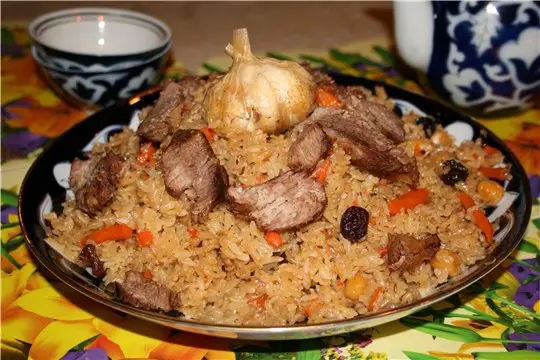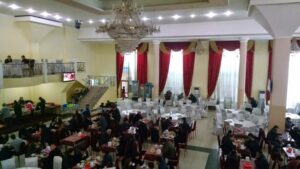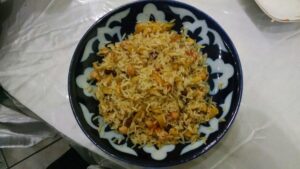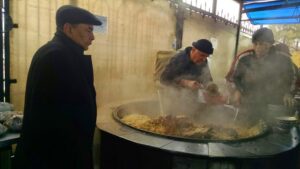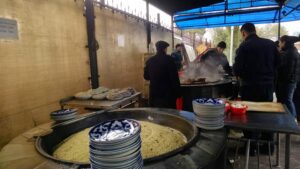Plov (Плов) is a hearty dish made from deep fried meat and vegetables, over which rice is cooked.
Plov is considered a national dish in many countries of Central Asia and the Near and Middle East ‒ Iran, Tajikistan, Uzbekistan, and Afghanistan. It is generally popular over most of the area that the Soviet Union once covered and more.
Why It’s Called “Plov”
(Почему так называется?)
The name “plov” is related to “pilaf,” a name which English speakers are generally familiar with. However, while “pilaf” usually refers to a light, mostly-vegetable dish, plov is much more hearty.
Alexander the Great (356 – 323 BC) is often credited with being the “inventor” of plov. The legendary military commander didn’t want his troops to have to stop in the field for breakfast, lunch, and dinner, so he ordered his Asian cook to prepare something “чтоб человек покушал один раз – и был сыт весь день” (so that a man could eat once and be full a whole day). The result was plov.
Alexander the Great referred to the dish as “poluv,” which means “diverse mixture” in ancient Greek. However, the Tajiks consider Ibn Sina (Avicenna), a 10th-century Persian scholar, to be the father “современного плова” (of modern plov). His name for it was “palov osh,” an acronym compiled from the basic list of ingredients (onions, carrots, meat, oil or fat, salt, water, and rice) as written in Uzbek. The dish is still called “osh” is Tajikistan.
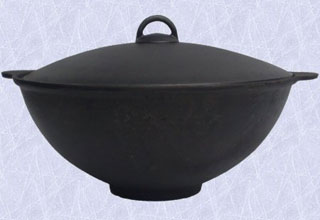
Another oft-told tale in Russia – and one that is likely more joke than history – is that plov got its name because it was originally eaten after riding horses all day. When one “спрыгивает с лошади после долгой езды” (hops off a horse after a long period of riding), it is said, one naturally makes a sound very similar to “plov!”
Plov is traditionally cooked in a large metal pot similar to a wok, but heavier. The pot is called a “казан” (kazan in Russian, qozon in Uzbek). The name of the Russian city Kazan is most likely derived from this pot – the city sits in kazan-shaped lowland and in ancient times sat mostly on a hill that resembles an overturned kazan. If you don’t have a kazan, don’t worry, “любой большой котел подойдёт” (any large cast iron pot will do).
How and When Plov is Eaten
(Как правильно есть плов?)
“Плов считается очень «демократичным» блюдом” (Plov is considered a very “democratic” food; meaning that most people can afford and enjoy it). This can be perhaps best summed in the famous Uzbek saying (presented here in Russian) that: “Если ты бедный — ты кушаешь плов. А если ты богатый — ты кушаешь только плов!” (If you are poor, you eat plov. And if you are rich, you eat nothing but plov.)
Plov is often made for special occasions such as weddings or the arrival of an honored guest. However, плов is also a staple dish, frequently made and eaten and can be easily bought as “уличная еда” (street food) in many Central Asian countries.
In much of Central Asia, like many Asian rice dishes, “плов принято есть руками и часто есть из общей тарелки или чашки” (plov is traditionally eaten with hands and often eaten from a communal bowl or plate). Russians, being much more European, tend to use separate plates and forks, however.
Being a substantial dish, “плов часто едят как отдельное блюдо” (plov is often eaten as a meal in itself). However, it is also often served with fresh herbs or vegetables, side salads of fresh tomato, cucumber, and/or onion, and sometimes onion slices soaked in small amount of diluted vinegar.
The traditional Uzbek drink is “кумыс” (kumys; a fermented milk drink, usually from cow or horse milk), but kefir makes a good substitute.
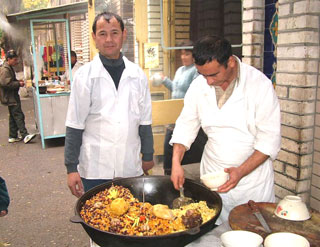
How to Prepare Plov
(Как правильно готовить плов?)
Plov is often made “на улице” (outdoors), with kazan, “расположенный над костром” (the kazan set over a open fire). It is also usually made by men.
Plov recipes differ from region to region – some cultures add more or less spices, leave out the carrots, or add raisins or other fruits and vegetables. However, most of the former Soviet Union is most familiar with a type of basic плов associated with Uzbekistan.
To make this dish, the meat used should never be too lean – “большие прослойки жира в мясе” (a good marbling of fat within the meat) is important to the dish. Most traditionally, lamb is used, although beef is also common and even “плов из курицы” (chicken plov) can be encountered. Pork is much rarer, perhaps because the dish is native to countries in which Muslims are dominant.
The meat is often cooked in large chunks to ensure that “мясо не теряет свою природную сочность” (the meat doesn’t lose its natural juices). The meat is then cut in smaller pieces before serving.
Tradition states “вода для плова должна отстояться не менее часа перед использованием” (the water for plov should “stand” for at least an hour before use). Most importantly, the water should be room temperature so that it does not slow the cooking process when added – or boil off too quickly. Some chefs use this tradition to flavor the water, adding “лук, чеснок, или травы, чтобы придать блюду лучший аромат” (onion, garlic, or herbs to infuse the dish with more flavor). To gain full flavor, the water should sit with these ingredients for 3-4 hours.
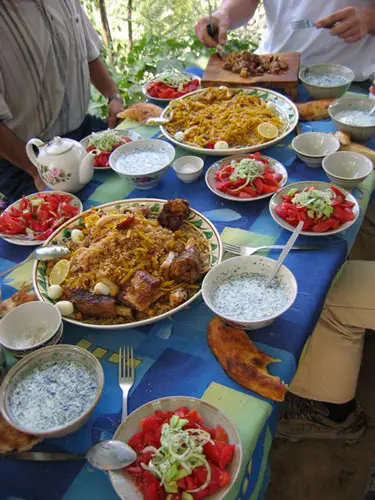
“Необходимо использовать длиннозерный рис с низким содержанием крахмала” (Long-grain, low-starch rice should be used). Make sure to rinse the rice in cold water several times – this will remove extra starch from the kernels, helping make sure “они не слипнутся в кашу даже после того, как впитают в себя воду и жир” (they remain individual and intact even as they absorb the water and oil). If you can possibly find it, “узбекский сорт риса “девзира”, который оптимально подходит для плова” (devzira is an Uzbek rice that is optimal for the dish).
Uzbek cuisine makes fine differentiation between types of oil and fat and even types of oil mixtures to gain just the right consistency. Drippings (usually from lamb), or vegetable oil such as “хлопковое, оливковое, подсолнечное, кукурузное, кунжутное, конопляное” (cottonseed, olive, sunflower, sesame, and hempseed) are used.
The plov should never be heavy or oily. Too much oil will prevent the rice from sticking together at all and the dish will become “soupy.” Oil is added proportionally to the rice, where 0.3 kg of oil is added per 1 kg of rice.
“Всегда предварительно разогревайте масло перед добавлением ингредиентов” (always make sure that the oil is preheated before adding ingredients). This will also help make sure that the oil does not hurt the consistency of the food. It should be very hot, but not boiling. To achieve the right temperature, add a small onion to the oil as it begins to heat – “когда лук приобретет темно-коричневый цвет, уберите лук, масло готово” (when the onion has turned a deep brown, remove it and the oil is ready). This has the additional benefits of flavoring and purifying the oil as well as adding more color to the plov.
In Russia, “смесь приправ для плова продается во многих магазинах” (packets of pre-mixed plov spices are sold in most stores). The most common ingredients in these mixes are black pepper, red pepper, salt, saffron, barberry, garlic, thyme, coriander, dill, and cilantro. “Добавьте другие имеющиеся у вас приправы по вкусу” (Try adding what you have available to taste).
In traditional style, whole cloves or even entire heads of garlic are added with the spices. The end result is “не острый чеснок, с легким привкусом карамели” (a very mild, slightly caramelized garlic) – quite unlike anything you’ve probably tried before.
Every time you make plov it turns out a little bit different, even if you use the exact same ingredients every time.
Plov Recipe
(Давай Приготовим!)
| Узбекский плов | Uzbek Plov |
Ингредиенты
Приготовление
|
Ingredients
Preparation
|
Central Asian Plov Center in Tashkent
This section was written by SRAS Graduate Sophia Rehm about her experience in 2014.
Plov is a major staple of Central Asia and can be found in many restaurants and cafes and even sold frozen in supermarkets. My experience in Tashkent, at the giant Central Asian Plov Center, shows how deeply popular this dish is here and how deeply engrained it is in the local culture.
Though I have tried плов (plov, or pilaf) in only one restaurant in Uzbekistan’s capital, I feel confident recommending Central Asian Plov Center at 1 Iftihor St. as a worthwhile destination in Tashkent for both the food quality and the experience. I had the opportunity to eat at Plov Center on a trip to Kazakhstan and Uzbekistan with SRAS’s Central Asian Studies study abroad program this November. A heaping portion here costs just $2.
Plov is eaten throughout Central Asia, but is considered a specialty of Uzbekistan. It is a rice dish, which almost always includes carrots, onions, and meat. Beyond that, plov varies by region and cook.
The highlight of Plov Center is outside the restaurant, where the плов is cooked in enormous, steaming vats, and stirred with long wooden spoons. Two vats are full of pale, just-cooked rice dotted with raisins. In a third, the rice is topped with large chunks of meat. Cooks and customers stand in the steam, and the plov is served outside, in plastic bowls, as well as in the restaurant’s large hall.
The plov at Plov Center is not what is cooked at home in a typical Tashkent kitchen. It has chickpeas and raisins, like плов prepared for weddings. It also includes meat, carrots, onions, chopped peppers, and whole boiled quail eggs. The rice, yellowish from the seasoned broth, is moist but not sticky. There are various types of meat to choose from: lamb, beef, and horse. Our group chose horse.
As a vegetarian, I can’t describe horse meat or speak directly to its quality at Plov Center, but I was told it was mild and delicious. I can say that Plov Center is not the best choice for strict vegetarians. The waiter was perfectly receptive to the request for плов without meat, but the rice was definitely cooked with meat, and had a very meaty taste (and a small, accidental piece or two of horse meat mixed in).
But for non-vegetarians – and vegetarians who don’t mind the taste of meat once in a while – the плов here is excellent. We also had delicious, fresh tomato and cucumber salad, large lepyoshki (лепёшки; round loaves of bread), and, of course, pots of green and black tea (чай). These dishes make up the entirety of Plov Center’s menu.
Inside, Plov Center is palatial, with a huge glass chandelier in the middle of the high ceiling, an ornate balcony with additional seating overhanging the main dining area, and regal floor-to-ceiling red drapes on the tall windows. Large groups are easily accommodated at round tables that seat at least nine or ten, or at smaller rectangular tables pushed together. Lunch hour was busy and buzzing, but not too loud, and there was no line for a table (the only lines were outside, for those who wanted their плов straight from the large vats, on the go).
Prices were very reasonable. A meal of salad, bread, tea, and (generously portioned) plov cost about 14,000 sum (or about $5.80).
An additional appeal of Plov Center is its location, next to the Tashkent Television Tower, which is the tallest structure in Central Asia, and near the Memorial to the Victims of Repressions. Central Asian Plov Center is the perfect place for a hearty lunch to fuel a day of exploring a magnificent city.
Our Favorite Plov Videos
All the secrets of a good plov can be found in this video featuring Stalic Khankishiev, a celebrity chef, photographer, and cooking writer born in Uzbekistan and well-known in Russia for his deep knowledge of Central Asian cuisine.
You Might Also Like
The Kyrgyz are a Turkic people with a rich identity that revolves around their nomadic heritage. Although they were forcibly settled by the Soviets, some have maintained or returned to nomadic traditions. Other strong elements of their culture include faith in Islam that is heavily informed by previous (or present) belief in Tengrism, Zoroastrianism, and […] Kyrgyz holidays include many inherited from the USSR (although most of those have changed their form at least slightly). Kyrgyz holidays also include many adopted from Russian culture. However, many holidays have now been added to the calendar to celebrate patriotism toward independent Kyrgyzstan and Kyrgyzstan’s long-held Muslim heritage. Thus, Soviet, national, Orthodox, Muslim, modern, […] For those obsessed with all things pumpkin — pumpkin pie, pumpkin ice-cream, pumpkin-spice lattes — oromo (оромо) is sure to please. Oromo is a rolled, layered, steamed pastry that comes with various fillings (pumpkin being common and our favorite). It evokes everything we love about pumpkin season back home in the States. This main dish […] Central Asia’s rich tradition of carpet weaving reflects the region’s history, culture, and identity. From the ancient nomads of the Pazyryk Valley to the artisans of Kyrgyz yurts and the urban weavers of Samarkand, carpets have long served both practical and symbolic functions. Their materials, techniques, and motifs reflect centuries of interaction between nomadic and […] The Talking Phrasebook Series presents useful phrases and words in side-by-side translation and with audio files specifically geared to help students work on listening skills and pronunciation. Below, you will find several useful phrases and words. To the left is the English and to the above right is an English transliteration of the Kyrgyz translation. […]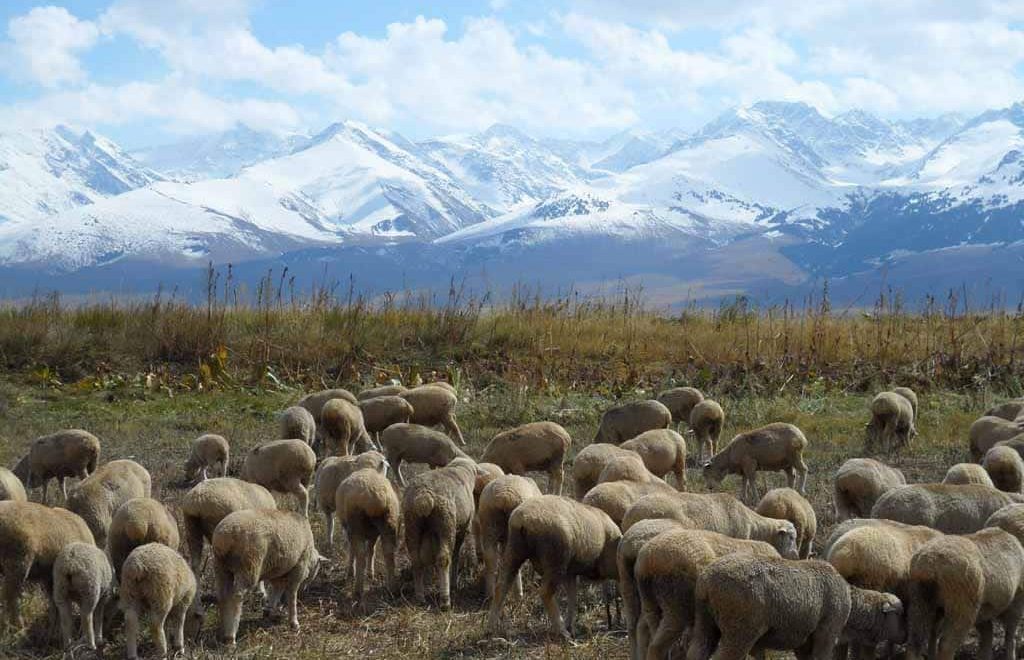
Sheep Guts Won’t Kill You: A Guide to Seeing the Kyrgyzstan that Most People Don’t
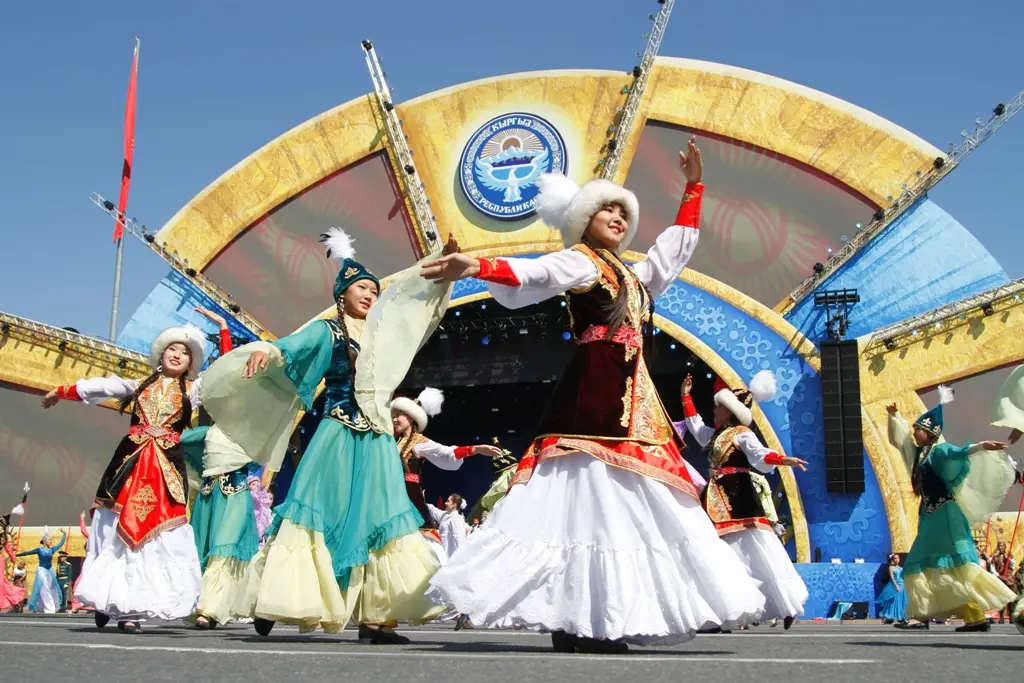
Kyrgyz Holidays 2026: A Complete Guide
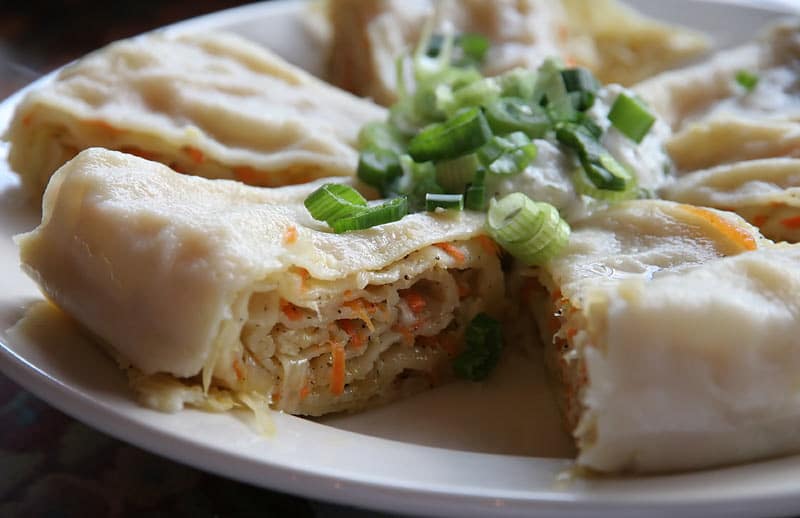
Oromo, Orama, Khanum: A Turkic Pumpkin Delight
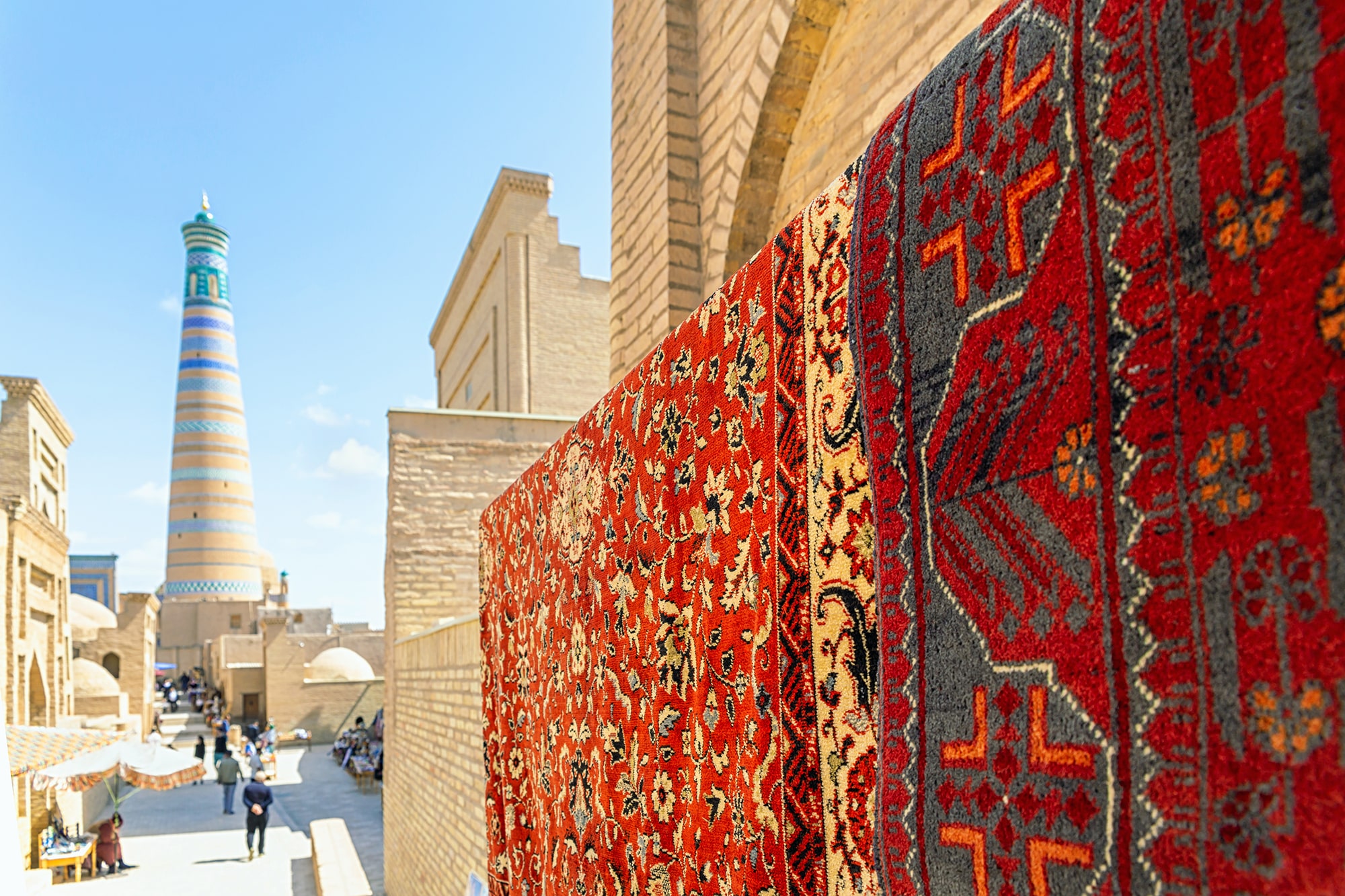
Knots of Culture: Central Asia’s Carpet Weaving Heritage

The Talking Kyrgyz Phrasebook

